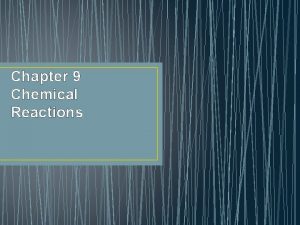Chapter 24 Chemical Reactions Chemical Reactions evidence of









- Slides: 9

Chapter 24: Chemical Reactions

Chemical Reactions evidence of chemical reactions

Section 1: Chemical Changes • Chemical reaction: a change in which one or more substances are converted into new substances • The substances that react together are called reactants • The new substances produced are called products • The mass of the reactants before the reaction MUST equal the products, according to the law of conservation of mass

Chemical Reactions glycerol and potassium permanganate dehydration of sugar sodium acetate

Describing Chemical Reactions • French chemist Antoine Lavoisier discovered this law in the late 1700 s. • He heated 10 grams of mercury (II) oxide in a sealed container • The compound bubbled and changed from a red powder (Hg. O) to a silver liquid (Hg) • He had 9. 3 grams of mercury, and 0. 7 grams of oxygen (9. 3 + 0. 7 = 10. 0 g) • Therefore, matter is conserved in a chemical reaction • video

Chemical Reactions pharaoh's snake Chemiluminescence phosphorus in oxygen

Writing Equations • Just like we write chemical formulas to save space, we can write chemical equations to show a chemical reaction • 2 Hg. O (s) 2 Hg (l) + O 2 (g) • 2 units of solid mercury (II) oxide produce 2 units of liquid mercury and 1 unit of oxygen gas • The 2’s in front of the Hg. O and the Hg are called coefficients • The letters in ( ) tell us the state of matter • (aq) means “dissolved in water”

Chemical Reactions http: //dsc. discovery. com/videos/mythbusters-diet-coke-and-mentos. html scifun. org

Review Questions Answer these questions for tomorrow: Cd(NO 3)2(aq) + H 2 S(g) Cd. S(s) + 2 HNO 3(aq) 1. Identify these items: 1. 2. 3. 4. Reactants Products Names States of matter 2. If you started with 15 grams of reactants, how much product should you get? 3. What might happen if chemical reactions did not obey the law of conservation of mass?
 Section 2 classifying chemical reactions
Section 2 classifying chemical reactions Section 2 classifying chemical reactions worksheet answers
Section 2 classifying chemical reactions worksheet answers Are kc and kp equal
Are kc and kp equal Types of reactions
Types of reactions Chapter 10 chemical reactions
Chapter 10 chemical reactions Chapter 9 chemical reactions test answers
Chapter 9 chemical reactions test answers Section 1 chemical changes
Section 1 chemical changes Chapter 9 chemical reactions
Chapter 9 chemical reactions Chapter 8 review chemical equations and reactions
Chapter 8 review chemical equations and reactions Chapter 9 study guide chemical reactions
Chapter 9 study guide chemical reactions

















